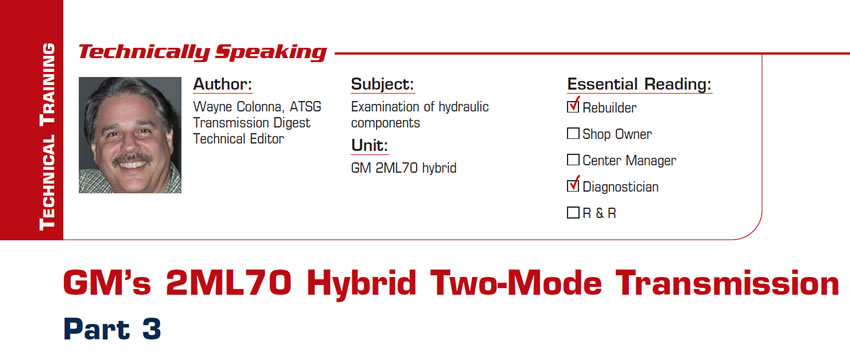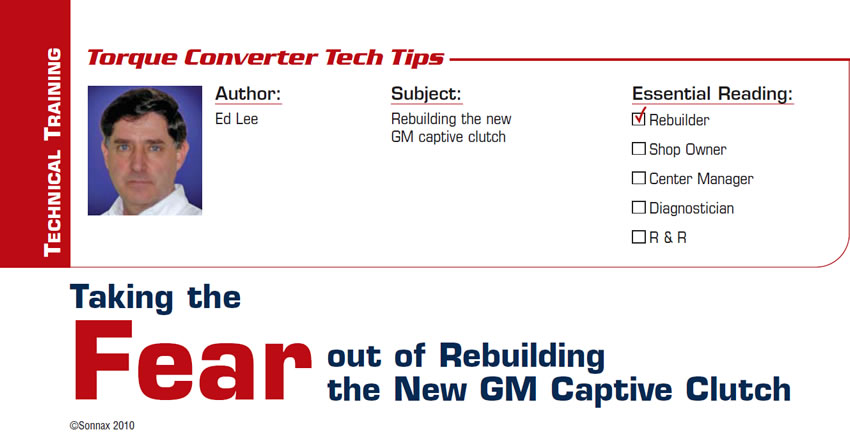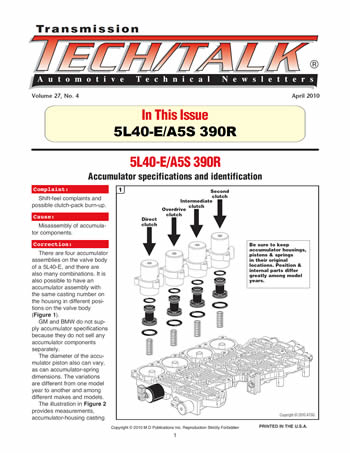GM’s 2ML70 Hybrid Two-Mode Transmission
Having looked at the electrical and mechanical aspects of this rear-wheel-drive two-mode hybrid transmission in the past two issues, a brief look at the hydraulic components will finalize our comprehensive overview of the 2ML70.

Taking the Fear out of Rebuilding the New GM Captive Clutch
The new General Motors captive clutch has four spring-steel straps that restrict the rotational movement of the piston. One end of each strap is riveted to the piston and the other end is riveted to the cover (figures 1a and 1b).

When You’re the Best, the Innovation Never Stops
Many of you in the transmission industry have found that it’s good business to supplement your primary activity with general-repair and maintenance services. When you get really busy with transmission work some of you kick the other activities to the curb to concentrate on the more-lucrative and familiar transmission repairs. I can totally understand and have been guilty of it myself in years gone by. The question is, “Can you still afford to run a hit-and-miss general-repair business or do you have to put forth an extra and ongoing effort to convert those sometime customers to regulars who can help you continually maintain and grow your shop’s income?”

Pattern Failure
The definition of a pattern failure as far as transmissions go is seeing the same wear issue or broken part in every transmission of that type. This is such a case.
We have similar transmissions in two different car makes, the 6T70 from GM and the 6F50 from Ford. These transmissions are almost identical as far as the internal parts and pieces go, but they are controlled differently. The parts that fail in the 6T70 are different from those that fail in the 6F50, say the manufacturers.

AW55-50: No Reverse; 09G/09K/09M: No Movement
I recently received a phone call from a shop that was working on a 2001 Volvo with an AW 55-50 transmission. The vehicle would not move when shifted from Park to Reverse. If the selector was first put into Drive then moved to Reverse, engagement was normal. The manual linkage was checked, confirming that the manual valve was in the reverse position.

The Magna Powertrain MP3023/3024 NQH
In last month’s article we discussed two of the three new models of transfer cases from Magna Powertrain, the MP1222/1225/1226 NQG and the MP1625/1626 NQF. This month we will discuss the operation and mechanical functions unique to the MP3023/3024 NQH. Figure 1 breaks down the identification code for the MP3023. These are active transfer cases (ATC) with sophisticated advanced electronics.

April 2010 Issue
In This Issue
5L40-E/A5S 390R: Accumulator specifications and identification

Back to the Basics: Strategy-Based Diagnosis
Later that day they showed up to drop off the car, a 2002 Volkswagen Jetta GLS with 72,000 miles (Figure 1). The owner of the car started to explain the concern he was having: “Everything was working great, then one day the check engine light came on and it started to shift real hard and fast. I took it to (shop A) and they said it was either the transmission control module or the transmission. If it was the module, it was going to be $2,000; if it was the transmission, $5,000 plus reprogramming and any wire repairs; or it could need both. I paid them $145 for looking at it, but I wanted to get a little more specific about what it was going to cost, so I took it to (shop B); they had it for a week and said they thought it needed a control module but were not real sure and asked me to take it somewhere else, so here I am.”

Car Gets New Life After Revamped DME System
The car sitting in front of my bay was towed in last night for a no-start problem. Looking at it gives me that “Here-I-go-again” feeling. The chalky paint is oxidized from infrared overexposure. A greenish hue of lichens blankets the exposed upper surfaces. The tags have been expired for two years. Disturbed ants crawl along the inner fender seam, originating from a bra that covers the front of the vehicle. There are no leaves or maple seeds in the cowl vents, so I assume it might have been residing in an apartment complex (covered parking) or perhaps a subdivision.

